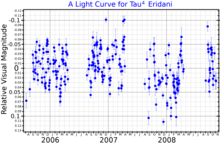

| Location of τ4 Eridani (circled) | |
| Observation data Epoch J2000.0 Equinox J2000.0 (ICRS) | |
|---|---|
| Constellation | Eridanus |
| Right ascension | 03h19m 31.0006s [1] |
| Declination | −21° 45′ 28.315″ [1] |
| Apparent magnitude (V) | 3.65[2] |
| Characteristics | |
| Evolutionary stage | asymptotic giant branch[3] |
| Spectral type | M3/4 III[4] |
| U−B color index | +1.79[2] |
| B−V color index | +1.61[2] |
| Variable type | Lb[5] |
| Astrometry | |
| Radial velocity (Rv) | +41.7±0.7[6] km/s |
| Proper motion (μ) | RA: +52.774 mas/yr[1] Dec.: +32.718 mas/yr[1] |
| Parallax (π) | 10.6153 ± 0.3213 mas[1] |
| Distance | 307 ± 9 ly (94 ± 3 pc) |
| Absolute magnitude (MV) | −0.79[7] |
| Details | |
| Mass | 1.95[8] M☉ |
| Radius | 103[9] R☉ |
| Luminosity | 1,537[10] L☉ |
| Surface gravity (log g) | 0.91[8] cgs |
| Temperature | 3,770[8] K |
| Other designations | |
τ4 Eridani, τ4 Eri, 16 Eridani, BD-22° 584, HD 20720, HIP 15474, HR 1003, SAO 168460.[11] | |
| Database references | |
| SIMBAD | data |
Tau4 Eridani (τ4 Eridani, τ4 Eri) is a binary star system in the constellation Eridanus. It is visible to the naked eye with an apparent visual magnitude of 3.65.[2] The distance to this star can be estimated using the parallax method, which yields a value of roughly 300 light years. [1]

This is an evolved red giant star currently on the asymptotic giant branch[3] with a stellar classification of M3/4 III.[4] It is a slow irregular variable star of type Lb, undergoing changes in magnitude over the range 3.57−3.72[5] with a periodicity of 23.8 d.[12] The measured angular diameter of Tau4 Eridani is 10.58±1.00 mas.[13] At its estimated distance, this yields a physical size of about 106 times the radius of the Sun.[14] It shines with 1,537[10] times the luminosity of the Sun from an outer atmosphere at an effective temperature of 3,770 K.[8]
This is most likely a binary star system.[15] The companion is a magnitude 9.5 star at an angular separation of 5.7″ along a position angle of 291°, as of 2013.[16]
{{cite web}}: CS1 maint: postscript (link)

|
| |||||||||||||
|---|---|---|---|---|---|---|---|---|---|---|---|---|---|
| |||||||||||||
| Stars |
| ||||||||||||
| |||||||||||||
| Nebulae |
| ||||||||||||
| Galaxies |
| ||||||||||||
| |||||||||||||
| |||||||||||||